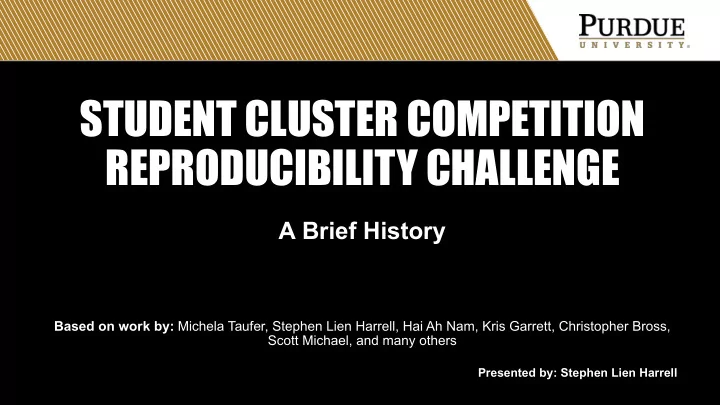

STUDENT CLUSTER COMPETITION REPRODUCIBILITY CHALLENGE A Brief History Based on work by: Michela Taufer, Stephen Lien Harrell, Hai Ah Nam, Kris Garrett, Christopher Bross, Scott Michael, and many others Presented by: Stephen Lien Harrell
REPRODUCIBILITY INITIATIVE AT SC Technical Program @ SC X Select one (1) SC X paper for SC X+1 SCC Select BP/BSP candidates Generate replication benchmark for diverse set of HPC platforms Student Cluster Competition @ SC X+1 Computational Results (CRA) Technical Program @ SC X+1 Assign badge Artifact Assign badge to SC X paper Descriptor (AD) Check AD or CRA SC X Partner with vendors Review papers Papers Build a cluster Test performance benchmarks Give SIGHPC certificate to Technical Program @ SC X+2 SC X paper authors Replicate SC X Paper Review ParCo SI paper with Present ParCo SI with SCC reports Generate replication reports SCC reports from SCC @ SC X+1 from SCC @ SC X-1
STUDENT CLUSTER COMPETITION (SCC) • Teams of 6 undergraduate students build and operate a small HPC cluster on the exhibit floor of SC every year since 2007 • The teams “race” their clusters to run data sets during the competition • Primary constraint is the machine must run within 3000 watts of power – this means we see many different hardware architectures
REPRODUCIBILITY CHALLENGE DETAILS • Each team runs a computational experiment from the chosen paper during the competition and attempts to reproduce computational results from the paper • The teams then write a report on how they implemented the experiment and what their findings were • These reports were published in PARCO special issues for SC16 and SC17 (volume 70 and 79 respectively) • Reproducibility Challenge Report Outline (4 Page Max) • Introduction • State the claims that the paper made and what is trying to be reproduced • Description of the HPC machine and environment • Description of the steps taken to reproduce • Data from the student’s experiment • Compare results to the original paper • Are they similar, why or why not? • Conclusion • Were you able to reproduce the results? • Along with the report the students were required to submit the output files from the application
SC16 SCC REPRODUCIBILITY CHALLENGE • Chosen paper • Flick, P., Jain, C., Pan, T., & Aluru, S. (2015, November). A parallel connectivity algorithm for de Bruijn graphs in metagenomic applications. In Proceedings of the International Conference for High Performance Computing, Networking, Storage and Analysis (p. 15). ACM. • Competition Challenge • Application from the paper is ParConnect • Used 2 un-released datasets so computation is done at the competition • Students were asked to use a profiler to determine MPI timings and reproduce Figure 3 from the paper • Students were asked to do a strong scaling study and compare their results to Figure 4
SC17 SCC REPRODUCIBILITY CHALLENGE • Chosen paper • Höhnerbach, M., Ismail, A. E., & Bientinesi, P. (2016, November). The vectorization of the tersoff multi-body potential: an exercise in performance portability. In Proceedings of the International Conference for High Performance Computing, Networking, Storage and Analysis (p. 7). IEEE Press. • Competition Challenge • Application from the paper is LAMMPS • A new unreleased dataset is used • Students were asked to reproduce performance timings in figures based on their architectures (Figure 4 and 5 for CPU and KNL, Figure 6 for GPU) • Students were asked to do a strong scaling study on both the original dataset in the paper and the new dataset and compare results to Figure 9.
SC18 SCC REPRODUCIBILITY CHALLENGE – STARTING TODAY! • Chosen paper • Uphoff, C., Rettenberger, S., Bader, M., Madden, E. H., Ulrich, T., Wollherr, S., & Gabriel, A. A. (2017, November). Extreme scale multi-physics simulations of the tsunamigenic 2004 sumatra megathrust earthquake. In Proceedings of the International Conference for High Performance Computing, Networking, Storage and Analysis (p. 21). ACM. • Can’t speak about the details as they have not been released to the students yet.
SC19 SCC REPRODUCIBILITY CHALLENGE – OPEN QUESTIONS • We will be reusing a lot of great work from the previous challenges • Main Question: How do we curate a set of artifacts and release those with the reports • What digital artifacts are appropriate to curate? • Containers? Metadata? Automation? • What information can one gleam by looking at the artifact along with the report to contrast the reports? • By architecture or approach for example • Is this useful to community at large? • It is extra work on top of the base challenge to do this. • Will community members ever look at the artifacts or attempt to replicate the work themselves? • If they did, would the artifacts of how it was reproduced be useful?
LINKS • All competition applications and challenges (including reproducibility) from SC15 to present • https://scholarworks.iu.edu/dspace/handle/2022/21179 • SC16 Reproducibility Challenge Paper and PARCO Journal • Paper: https://doi.org/10.1145/2807591.2807619 • Journal: https://doi.org/10.1016/j.parco.2017.10.002 • SC17 Reproducibility Challenge Paper and PARCO Journal • Paper: https://doi.org/10.1109/SC.2016.6 • Journal: https://doi.org/10.1016/j.parco.2018.10.001 • SC18 Reproducibility Challenge Paper • Paper: https://doi.org/10.1145/3126908.3126948
Recommend
More recommend